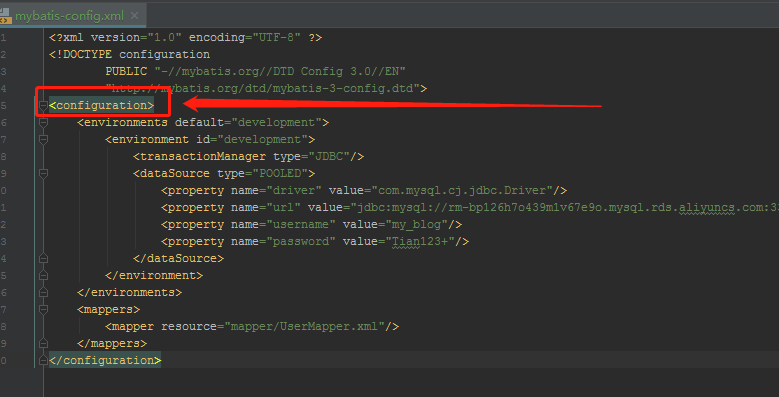在以前文章中,我们把Mybatis源码阅读的整个流程梳理了一遍。今天,我们来详细聊聊,Mybatis是如何解析配置文件的。
这是今天分析的流程图:

还是从案例开始。
demo案例
public static void main(String[] args) {
String resource = "mybatis-config.xml";
InputStream inputStream = null;
SqlSession sqlSession = null;
try {
inputStream = Resources.getResourceAsStream(resource);
SqlSessionFactory sqlSessionFactory = new SqlSessionFactoryBuilder().build(inputStream);
sqlSession = sqlSessionFactory.openSession();
UserMapper userMapper = sqlSession.getMapper(UserMapper.class);
System.out.println(userMapper.selectById(1));
} catch (Exception e) {
e.printStackTrace();
} finally {
try {
inputStream.close();
} catch (IOException e) {
e.printStackTrace();
}
sqlSession.close();
}
}
见证奇迹
从SqlSessionFactoryBuilder开始。
SqlSessionFactoryBuilder类
org.apache.ibatis.session.SqlSessionFactoryBuilder
该类里全是build方法各种重载。

//这个方法啥也没干
public SqlSessionFactory build(InputStream inputStream) {
return build(inputStream, null, null);
}
最终来到另外一个build方法里:
public SqlSessionFactory build(InputStream inputStream, String environment, Properties properties) {
try {
//创建一个XMLConfigBuilder对象
XMLConfigBuilder parser = new XMLConfigBuilder(inputStream, environment, properties);
return build(parser.parse());
} catch (Exception e) {
throw ExceptionFactory.wrapException("Error building SqlSession.", e);
} finally {
ErrorContext.instance().reset();
try {
inputStream.close();
} catch (IOException e) {
// Intentionally ignore. Prefer previous error.
}
}
}
XMLConfigBuilder类
该类的构造方法重载:

首先进入:
public XMLConfigBuilder(InputStream inputStream, String environment, Properties props) {
this(new XPathParser(inputStream, true, props, new XMLMapperEntityResolver()), environment,
props);
}
private XMLConfigBuilder(XPathParser parser, String environment, Properties props) {
super(new Configuration());
ErrorContext.instance().resource("SQL Mapper Configuration");
this.configuration.setVariables(props);
this.parsed = false;
this.environment = environment;
this.parser = parser;
}
build(parser.parse());中的parser.parse();
mybatis-config.xml在哪里解析的呢?
请看下面这个方法:
//该方法返回一个Configuration对象
public Configuration parse() {
if (parsed) {
throw new BuilderException("Each XMLConfigBuilder can only be used once.");
}
parsed = true;
//关键点
parseConfiguration(parser.evalNode("/configuration"));
return configuration;
}
parseConfiguration(parser.evalNode("/configuration"));
终于看到开始解析配置文件了:

进入方法parseConfiguration。
private void parseConfiguration(XNode root) {
try {
//issue #117 read properties first
propertiesElement(root.evalNode("properties"));
Properties settings = settingsAsProperties(root.evalNode("settings"));
loadCustomVfs(settings);
loadCustomLogImpl(settings);
typeAliasesElement(root.evalNode("typeAliases"));
pluginElement(root.evalNode("plugins"));
objectFactoryElement(root.evalNode("objectFactory"));
objectWrapperFactoryElement(root.evalNode("objectWrapperFactory"));
reflectorFactoryElement(root.evalNode("reflectorFactory"));
settingsElement(settings);
// read it after objectFactory and objectWrapperFactory issue #631
environmentsElement(root.evalNode("environments"));
databaseIdProviderElement(root.evalNode("databaseIdProvider"));
typeHandlerElement(root.evalNode("typeHandlers"));
mapperElement(root.evalNode("mappers"));
} catch (Exception e) {
throw new BuilderException("Error parsing SQL Mapper Configuration. Cause: " + e, e);
}
}
这里就是把mybatis-config.xml内容解析,然后设置到Configuration对象中。
那么我们定义的Mapper.xml是在哪里解析的呢?
我们的Mapper.xml在mybatis-config.xml中的配置是这样的:

//1使用类路径
//2使用绝对url路径
//3使用java类名
//4自动扫描包下所有映射器
继续源码分析,我们在上面mybatis-config.xml解析中可以看到:

我们不妨进入这个方法看看:
private void mapperElement(XNode parent) throws Exception {
if (parent != null) {
for (XNode child : parent.getChildren()) {
//自动扫描包下所有映射器
if ("package".equals(child.getName())) {
String mapperPackage = child.getStringAttribute("name");
//放
configuration.addMappers(mapperPackage);
} else {
String resource = child.getStringAttribute("resource");
String url = child.getStringAttribute("url");
String mapperClass = child.getStringAttribute("class");
//使用java类名
if (resource != null && url == null && mapperClass == null) {
ErrorContext.instance().resource(resource);
//根据文件存放目录,读取XxxMapper.xml
InputStream inputStream = Resources.getResourceAsStream(resource);
//映射器比较复杂,调用XMLMapperBuilder
//注意在for循环里每个mapper都重新new一个XMLMapperBuilder,来解析
XMLMapperBuilder mapperParser = new XMLMapperBuilder(inputStream, configuration, resource, configuration.getSqlFragments());
mapperParser.parse();
//使用绝对url路径
} else if (resource == null && url != null && mapperClass == null) {
ErrorContext.instance().resource(url);
InputStream inputStream = Resources.getUrlAsStream(url);
//映射器比较复杂,调用XMLMapperBuilder
XMLMapperBuilder mapperParser = new XMLMapperBuilder(inputStream, configuration, url, configuration.getSqlFragments());
mapperParser.parse();
//使用类路径
} else if (resource == null && url == null && mapperClass != null) {
Class<?> mapperInterface = Resources.classForName(mapperClass);
//直接把这个映射加入配置
configuration.addMapper(mapperInterface);
} else {
throw new BuilderException("A mapper element may only specify a url, resource or class, but not more than one.");
}
}
}
}
}
这里刚刚和我们的上面说的
到这里,配置文件mybatis-config.xml和我们定义映射文件XxxMapper.xml就全部解析完成。
回到SqlSessionFactoryBuilder类
前面讲到了XMLConfigBuilder中的parse方法,并返回了一个Configuration对象。
build(parser.parse());
这个build方法就是传入一个Configuration对象,然后构建一个DefaultSqlSession对象。
public SqlSessionFactory build(Configuration config) {
return new DefaultSqlSessionFactory(config);
}
继续回到我们的demo代码中这一行代码里:
SqlSessionFactory sqlSessionFactory = new SqlSessionFactoryBuilder().build(inputStream);
这一行代码就相当于:
SqlSessionFactory sqlSessionFactory = new new DefaultSqlSessionFactory();
到这里,我们的整个流程就搞定了。